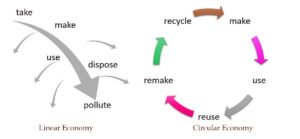Ecological systems have been surviving on earth for a long time and will continue to exist in the far future. But considering today’s living environment and approaches to deal with it, makes it impossible to think about survival. We follow the linear economy system which involves take, make and dispose of. This concept treats resources as infinite. We take resources from nature, make goods and after using these goods we dispose of them which creates an infinite number of non-biodegradable waste materials. This kind of system is impossible to sustain in the long term. We need to deal with this with much smarter and practically designed approaches. So, from here comes the need for circular economy or circularity.
What is the Circular Economy?
The Circular economy treats the material as finite. A company in the circular economy not just manufactures the product but also maintains ownership of the product all along. It involves steps of make, use, and return. In simple words, instead of throwing away and replacing the old ones, we adopt a return policy by regenerating and reusing products. For example metal, glass, wood, paper, etc can be reused again instead of dumping them. A more interesting and different approach can be using products on lease. There are companies that provide you services on the basis of the nominal monthly rent. This way, products that we use on a daily basis like furniture, electrical appliances, etc can be reused, repaired or refurbished. This benefits both companies and consumers.

Benefits of Circular Economy
By 2050, two-third of the population will be living in cities. Under our current take-make-dispose economy, cities consume over 75% of natural resources, produce over 50% of global waste and emit 80% of greenhouse gases. But these are also the places which provide better opportunities of education, finance, innovation, and culture. The circular economy will provide a kind of environment in cities that will help human resources to develop and thrive in better living conditions.
- This transition to the circular economy helps to meet our priorities of housing, transportation, and economic development.
- A circular economy is the future. The model reduces our dependency of the extraction of raw materials and replaces it with the materials already in use.
- Combined with the use of renewable sources of energy, reduced environmental damage, great industrial efficiency, a circular economy provides us the best way to live within the bounds of earth’s capacity.
- Innovative ideas, drawing on circular economy works on ways to convert into income streams. This helps to create organized infrastructure and waste management systems.
Implementation of Circular Economy
Implementation of the circular economy can be done keeping the following principles in mind
- Design out for waste and pollution
- Avoid creating waste in the first place.
- Using materials that can be reused, recycled or composted.
- Make use of every possible space in buildings, transportation, and planning.
- Reusing of key products
Products no longer in use can be reused, repairs or refurbished. The key products used in the manufacturing process can be restored.
- Regenerate natural systems
Valuable materials taken from natural resources should return to nature.

Circular Economy in Cities and Construction
The construction sector is based on standards of productivity that have not evolved over the past 25 years. Outdated linear economy and production methods require huge resources which makes construction one of the most damaging human activities. It leads to the constant extraction of natural resources and causes 35% of total CO2 emission.
Problems are also faced in terms of land use and heavy construction. An average life span of a building is considered around 100 years and if construction is done without sustainability principles keeping in mind, it is a lifelong source of pollution.
- Adequate management of construction and demolition waste needs to be done. Reusable resources like metal, stone, concrete, wood, ceramic etc should be identified and separated.
- Advanced technologies have entered in the industries. Architects and engineers have started to design in a way that makes infrastructure long-lasting, easy maintenance. Materials used are reusable, recyclable and can be repaired or refurbished.
- New concepts of eco-village are coming up capable of producing renewable energy, self-maintaining water, and waste management systems.
We have an incredible opportunity to open up to new perspectives instead of remaining trapped in the old techniques. We can rethink and redesign the products we design that are safe and easy to dispose of or reused again and again. Transitioning from linear to a circular economy may have its initial costs buts it’s the best and most important for the upcoming future.



